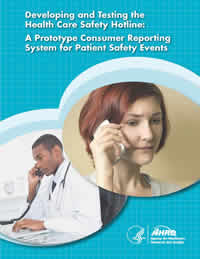Contract Final Report
This report describes the development, testing, and evaluation of the Health Care Safety Hotline, a prototype system for collecting narrative and structured data from consumers and patients on their concerns about the safety of their health care. The Hotline allows patients, family members, and caregivers to report patient safety problems, including errors and adverse events, on a secure Web site or by calling a toll-free phone number. The Hotline also can provide data, with the consumer’s permission, back to the health care provider or organization.
Prepared for:
Agency for Healthcare Research and Quality
Rockville, MD
Contract No. HHSA290201000017I
Prepared by:
RAND Corporation
RANDHealth
Santa Monica, CA
Contents
Acknowledgments
Preface
Summary
I. Introduction
Value of Patient Reporting
Consumer Reporting Systems: Realizing the Potential
The Charge from AHRQ
Focus of This Research
Purpose and Outline of This Report
II. Hotline Design and Development
Design Considerations
Creating the Event Reporting Form
The Final Reporting Form
Designing a Web-Based Data Collection Platform
Protocols for Data Collection, Processing, and Sharing
Clarifying Legal and Regulatory Protections for the Data
Summary
III. Hotline Implementation and Refinement
Selecting the Pilot Community and Health Care Organizations
Developing and Implementing an Outreach and Marketing Plan
Launch
Refining the Prototype
Extending the Outreach
Summary
IV. Evaluation Aims, Methods, and Results
Methods
Evaluation Results
Summary
V. Challenges Identified and Lessons Learned
Challenges
Lessons Learned
VI. Summary and Conclusions
References
Appendixes
Appendix A. Recommendations for Ideal Consumer Reporting Systems (PDF File, 30 KB)
Appendix B. Technical Expert Panel Members (PDF File, 15 KB)
Appendix C. Operations Manual (PDF File, 1.4 MB)
Appendix D. Hotline Site Visit Interview Protocol (PDF File, 48 KB)
Persons using assistive technology may not be able to fully access information in Appendix C. If you need help accessing this document, please contact Lisa Krever, AHRQ’s Center for Quality Improvement and Patient Safety, at lisa.krever@ahrq.hhs.gov, phone 301-427-1306.
Acknowledgments
This report was prepared by RAND health, Santa Monica, CA, for the Agency for Healthcare Research and Quality under contract HHSA2902010000171. The following investigators authored the report: Eric C. Schneider, M. Susan Ridgely, Denise D. Quigley, Lauren E. Hunter, and Kristin J. Leuschner, RAND Health; Saul N. Weingart, Tufts Medical Center; Joel S. Weissman, Brigham and Women’s Hospital; and Karen P. Zimmer and Robert C. Giannini, ECRI Institute - ACTION II Teaming Partner.
We are grateful to James Battles, our Project Officer, as well as Erin Grace, Amy Helwig, Jeff Brady, Lorin Smith, and Farah Englert of the Agency for Healthcare Research and Quality (AHRQ), for their support and guidance at all stages of this project. As a project team, we greatly benefited from the knowledge and expertise of our Technical Expert Panel, who provided us with valuable feedback on the design of the prototype, its implementation, and the evaluation findings. Saul Weingart chaired the expert panel, which included Troy Brennan, John Clarke, James Conway, Jack Fowler, Tejal Gandhi, Helen Haskell, Lisa McGiffert, Richard Roberts, and Diane Pinakiewicz.
We also extend our gratitude to our two pilot community partners—health care delivery organizations that participated with us in implementing and testing the consumer hotline prototype. We are indebted to these organizations, their patient safety leadership, and their Patient and Family Advisory Councils for the generosity of their time commitment and the valuable input they provided. We also thank Shaela Moen, Monica Hertzman, Lee Floyd, and Deanna Lee of RAND and Gregory Lee of ECRI Institute for their contributions to the project and this report.
The RAND quality assurance process employs peer reviewers, including at least one who is external to RAND. This report benefited from two rigorous technical reviews that improved the quality and clarity of the material presented.
Disclaimers
None of the investigators have any affiliations or financial involvements that conflict with the material presented in this report.
The opinions presented in this report are those of the authors, who are responsible for its content, and do not necessarily reflect the position of the U.S. Department of Health and Human Services or the Agency for Healthcare Research and Quality.




